Cross-Cultural Management: Analyzing Negotiation Challenges
VerifiedAdded on 2023/06/13
|10
|2546
|113
Case Study
AI Summary
This case study examines cross-cultural management issues arising between Ahaln Wilhelm and Mr. Haider, focusing on differences in cultural dimensions like universalism vs. particularism, individualism vs. communitarianism, and specific vs. diffuse orientations. The analysis identifies key management challenges, including communication styles, punctuality, trust, and negotiation approaches, and explains how these issues are rooted in differing cultural value orientations. The study proposes using the RADPAC model (Rapport, Analysis, Debate, Propose, Agreement, Close) to improve negotiation processes and mitigate cross-cultural misunderstandings, emphasizing the importance of understanding ethnic differences, building trust, and maintaining professionalism in international business interactions. The case concludes by highlighting the significance of cultural awareness in achieving successful business outcomes.

Cross Cultural Management
Paraphrase This Document
Need a fresh take? Get an instant paraphrase of this document with our AI Paraphraser

TABLE OF CONTENT
INTRODUCTION...........................................................................................................................3
MAIN BODY..................................................................................................................................3
TASK 1: Situational analysis:.........................................................................................................3
Seven dimensions of the culture and its impact-.........................................................................3
Analysing behaviour of both in according to case study-............................................................4
TASK 2 Cross culture management issues......................................................................................5
Identify and critically analysing the main cross culture management issue faced by Wilhelm's
business particularly with respect to management task and economic issue:.............................5
Explaining effect of management issue by cultural value orientation in model of culture:........5
TASK 3: Action recommendation...................................................................................................6
Critically evaluating the cultural difference that are impacting the tree facets of negotiation in
the case study:..............................................................................................................................6
Model of negotiation in improving cross-cultural management issue:.......................................7
CONCLUSION................................................................................................................................8
REFERENCES................................................................................................................................1
INTRODUCTION...........................................................................................................................3
MAIN BODY..................................................................................................................................3
TASK 1: Situational analysis:.........................................................................................................3
Seven dimensions of the culture and its impact-.........................................................................3
Analysing behaviour of both in according to case study-............................................................4
TASK 2 Cross culture management issues......................................................................................5
Identify and critically analysing the main cross culture management issue faced by Wilhelm's
business particularly with respect to management task and economic issue:.............................5
Explaining effect of management issue by cultural value orientation in model of culture:........5
TASK 3: Action recommendation...................................................................................................6
Critically evaluating the cultural difference that are impacting the tree facets of negotiation in
the case study:..............................................................................................................................6
Model of negotiation in improving cross-cultural management issue:.......................................7
CONCLUSION................................................................................................................................8
REFERENCES................................................................................................................................1

INTRODUCTION
Cross cultural management is the concept which involves the different culture background
and dynamic background in the management. This study mainly focuses on training and
inspiring the employees to deal with the diverse culture in the organization (Browaeys and Price
2019). This case study enables to understand the seven dimensions of the culture (Hannichenko
2021) and its impacts on the organization and also the impact on both the person involved in this
case study. Along with this, it has analyse about the issues faced by wilhelm business as well as
how both of them can improve the cross cultural management.
MAIN BODY
TASK 1: Situational analysis:
Seven dimensions of the culture and its impact-
1. Universalism vs particularism- In universalism type of culture, organization highly
focuses on following the rules, values, laws and obligations. They give more importance
to rules and laws rather than relationships(Carolina 2019). In particularism type of
culture, relationships are also involved in the businesses for any purpose of work. Mr.
Haider follows particularism and Ahaln Wilhelm follows universalism.
2. Individualism vs communitarianism- In individualism context, there is believed in
freedom and achievement. It states that the decisions should by taken by ourselves only
which means taking care of yourself. In communitarianism, it believes that group is given
priority then the individual. It also states that group gives health and safety in return of
loyalty. Individualism is followed by Ahaln Wilhelm and communitarianism by Mr.
Haider.
3. Specific vs Diffuse- Specific culture is that in which people keep the personal life
separate from the professional life. They believe that good relations are important but
without good relations also organization can achieve the goals and objectives. In contrary
to this, in diffuse culture is that in which good relationships are given more priority for
meeting the goals and objectives of the organization. Mr. Haider follows diffuse culture
whereas, Ahaln Wilhelm follows specific culture.
Cross cultural management is the concept which involves the different culture background
and dynamic background in the management. This study mainly focuses on training and
inspiring the employees to deal with the diverse culture in the organization (Browaeys and Price
2019). This case study enables to understand the seven dimensions of the culture (Hannichenko
2021) and its impacts on the organization and also the impact on both the person involved in this
case study. Along with this, it has analyse about the issues faced by wilhelm business as well as
how both of them can improve the cross cultural management.
MAIN BODY
TASK 1: Situational analysis:
Seven dimensions of the culture and its impact-
1. Universalism vs particularism- In universalism type of culture, organization highly
focuses on following the rules, values, laws and obligations. They give more importance
to rules and laws rather than relationships(Carolina 2019). In particularism type of
culture, relationships are also involved in the businesses for any purpose of work. Mr.
Haider follows particularism and Ahaln Wilhelm follows universalism.
2. Individualism vs communitarianism- In individualism context, there is believed in
freedom and achievement. It states that the decisions should by taken by ourselves only
which means taking care of yourself. In communitarianism, it believes that group is given
priority then the individual. It also states that group gives health and safety in return of
loyalty. Individualism is followed by Ahaln Wilhelm and communitarianism by Mr.
Haider.
3. Specific vs Diffuse- Specific culture is that in which people keep the personal life
separate from the professional life. They believe that good relations are important but
without good relations also organization can achieve the goals and objectives. In contrary
to this, in diffuse culture is that in which good relationships are given more priority for
meeting the goals and objectives of the organization. Mr. Haider follows diffuse culture
whereas, Ahaln Wilhelm follows specific culture.
⊘ This is a preview!⊘
Do you want full access?
Subscribe today to unlock all pages.

Trusted by 1+ million students worldwide
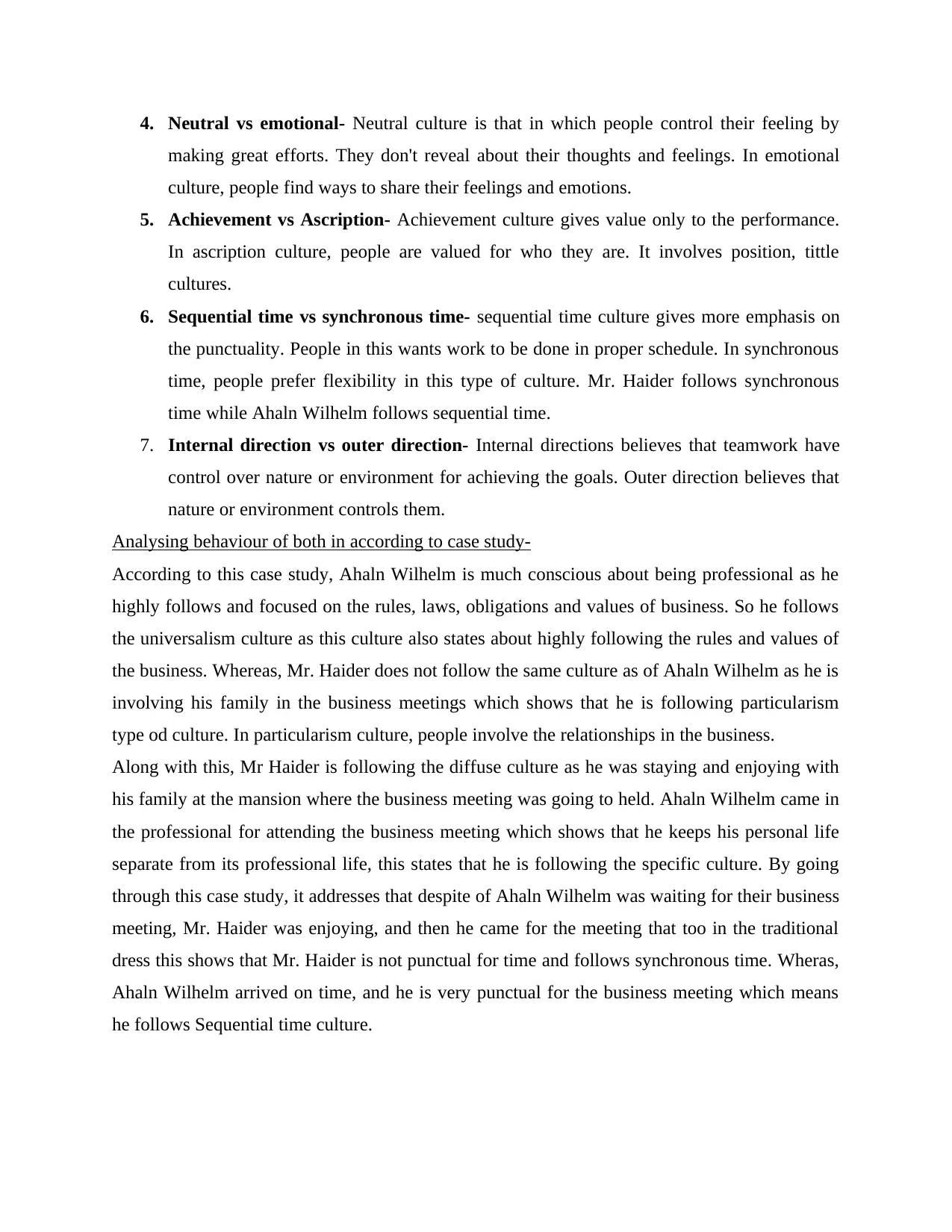
4. Neutral vs emotional- Neutral culture is that in which people control their feeling by
making great efforts. They don't reveal about their thoughts and feelings. In emotional
culture, people find ways to share their feelings and emotions.
5. Achievement vs Ascription- Achievement culture gives value only to the performance.
In ascription culture, people are valued for who they are. It involves position, tittle
cultures.
6. Sequential time vs synchronous time- sequential time culture gives more emphasis on
the punctuality. People in this wants work to be done in proper schedule. In synchronous
time, people prefer flexibility in this type of culture. Mr. Haider follows synchronous
time while Ahaln Wilhelm follows sequential time.
7. Internal direction vs outer direction- Internal directions believes that teamwork have
control over nature or environment for achieving the goals. Outer direction believes that
nature or environment controls them.
Analysing behaviour of both in according to case study-
According to this case study, Ahaln Wilhelm is much conscious about being professional as he
highly follows and focused on the rules, laws, obligations and values of business. So he follows
the universalism culture as this culture also states about highly following the rules and values of
the business. Whereas, Mr. Haider does not follow the same culture as of Ahaln Wilhelm as he is
involving his family in the business meetings which shows that he is following particularism
type od culture. In particularism culture, people involve the relationships in the business.
Along with this, Mr Haider is following the diffuse culture as he was staying and enjoying with
his family at the mansion where the business meeting was going to held. Ahaln Wilhelm came in
the professional for attending the business meeting which shows that he keeps his personal life
separate from its professional life, this states that he is following the specific culture. By going
through this case study, it addresses that despite of Ahaln Wilhelm was waiting for their business
meeting, Mr. Haider was enjoying, and then he came for the meeting that too in the traditional
dress this shows that Mr. Haider is not punctual for time and follows synchronous time. Wheras,
Ahaln Wilhelm arrived on time, and he is very punctual for the business meeting which means
he follows Sequential time culture.
making great efforts. They don't reveal about their thoughts and feelings. In emotional
culture, people find ways to share their feelings and emotions.
5. Achievement vs Ascription- Achievement culture gives value only to the performance.
In ascription culture, people are valued for who they are. It involves position, tittle
cultures.
6. Sequential time vs synchronous time- sequential time culture gives more emphasis on
the punctuality. People in this wants work to be done in proper schedule. In synchronous
time, people prefer flexibility in this type of culture. Mr. Haider follows synchronous
time while Ahaln Wilhelm follows sequential time.
7. Internal direction vs outer direction- Internal directions believes that teamwork have
control over nature or environment for achieving the goals. Outer direction believes that
nature or environment controls them.
Analysing behaviour of both in according to case study-
According to this case study, Ahaln Wilhelm is much conscious about being professional as he
highly follows and focused on the rules, laws, obligations and values of business. So he follows
the universalism culture as this culture also states about highly following the rules and values of
the business. Whereas, Mr. Haider does not follow the same culture as of Ahaln Wilhelm as he is
involving his family in the business meetings which shows that he is following particularism
type od culture. In particularism culture, people involve the relationships in the business.
Along with this, Mr Haider is following the diffuse culture as he was staying and enjoying with
his family at the mansion where the business meeting was going to held. Ahaln Wilhelm came in
the professional for attending the business meeting which shows that he keeps his personal life
separate from its professional life, this states that he is following the specific culture. By going
through this case study, it addresses that despite of Ahaln Wilhelm was waiting for their business
meeting, Mr. Haider was enjoying, and then he came for the meeting that too in the traditional
dress this shows that Mr. Haider is not punctual for time and follows synchronous time. Wheras,
Ahaln Wilhelm arrived on time, and he is very punctual for the business meeting which means
he follows Sequential time culture.
Paraphrase This Document
Need a fresh take? Get an instant paraphrase of this document with our AI Paraphraser
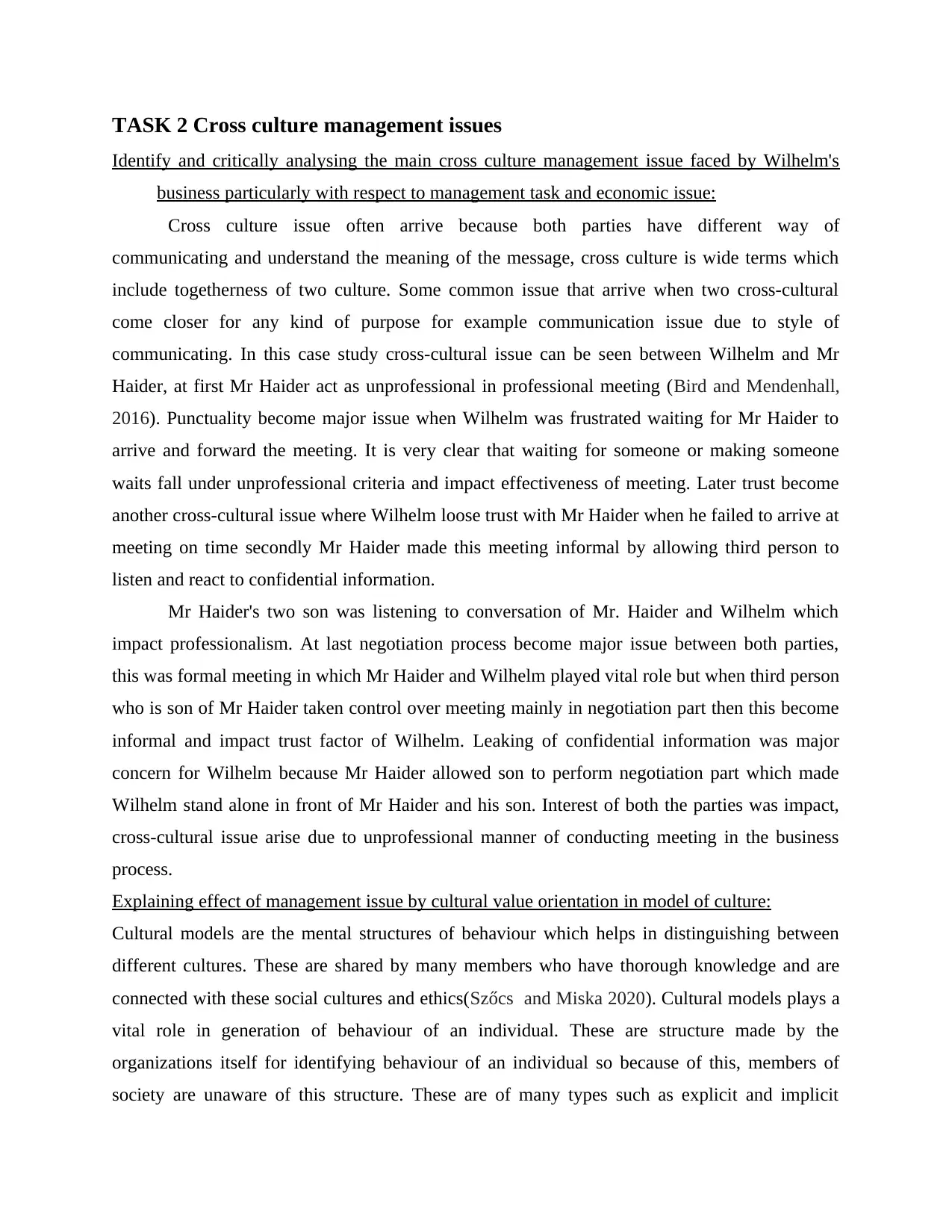
TASK 2 Cross culture management issues
Identify and critically analysing the main cross culture management issue faced by Wilhelm's
business particularly with respect to management task and economic issue:
Cross culture issue often arrive because both parties have different way of
communicating and understand the meaning of the message, cross culture is wide terms which
include togetherness of two culture. Some common issue that arrive when two cross-cultural
come closer for any kind of purpose for example communication issue due to style of
communicating. In this case study cross-cultural issue can be seen between Wilhelm and Mr
Haider, at first Mr Haider act as unprofessional in professional meeting (Bird and Mendenhall,
2016). Punctuality become major issue when Wilhelm was frustrated waiting for Mr Haider to
arrive and forward the meeting. It is very clear that waiting for someone or making someone
waits fall under unprofessional criteria and impact effectiveness of meeting. Later trust become
another cross-cultural issue where Wilhelm loose trust with Mr Haider when he failed to arrive at
meeting on time secondly Mr Haider made this meeting informal by allowing third person to
listen and react to confidential information.
Mr Haider's two son was listening to conversation of Mr. Haider and Wilhelm which
impact professionalism. At last negotiation process become major issue between both parties,
this was formal meeting in which Mr Haider and Wilhelm played vital role but when third person
who is son of Mr Haider taken control over meeting mainly in negotiation part then this become
informal and impact trust factor of Wilhelm. Leaking of confidential information was major
concern for Wilhelm because Mr Haider allowed son to perform negotiation part which made
Wilhelm stand alone in front of Mr Haider and his son. Interest of both the parties was impact,
cross-cultural issue arise due to unprofessional manner of conducting meeting in the business
process.
Explaining effect of management issue by cultural value orientation in model of culture:
Cultural models are the mental structures of behaviour which helps in distinguishing between
different cultures. These are shared by many members who have thorough knowledge and are
connected with these social cultures and ethics(Szőcs and Miska 2020). Cultural models plays a
vital role in generation of behaviour of an individual. These are structure made by the
organizations itself for identifying behaviour of an individual so because of this, members of
society are unaware of this structure. These are of many types such as explicit and implicit
Identify and critically analysing the main cross culture management issue faced by Wilhelm's
business particularly with respect to management task and economic issue:
Cross culture issue often arrive because both parties have different way of
communicating and understand the meaning of the message, cross culture is wide terms which
include togetherness of two culture. Some common issue that arrive when two cross-cultural
come closer for any kind of purpose for example communication issue due to style of
communicating. In this case study cross-cultural issue can be seen between Wilhelm and Mr
Haider, at first Mr Haider act as unprofessional in professional meeting (Bird and Mendenhall,
2016). Punctuality become major issue when Wilhelm was frustrated waiting for Mr Haider to
arrive and forward the meeting. It is very clear that waiting for someone or making someone
waits fall under unprofessional criteria and impact effectiveness of meeting. Later trust become
another cross-cultural issue where Wilhelm loose trust with Mr Haider when he failed to arrive at
meeting on time secondly Mr Haider made this meeting informal by allowing third person to
listen and react to confidential information.
Mr Haider's two son was listening to conversation of Mr. Haider and Wilhelm which
impact professionalism. At last negotiation process become major issue between both parties,
this was formal meeting in which Mr Haider and Wilhelm played vital role but when third person
who is son of Mr Haider taken control over meeting mainly in negotiation part then this become
informal and impact trust factor of Wilhelm. Leaking of confidential information was major
concern for Wilhelm because Mr Haider allowed son to perform negotiation part which made
Wilhelm stand alone in front of Mr Haider and his son. Interest of both the parties was impact,
cross-cultural issue arise due to unprofessional manner of conducting meeting in the business
process.
Explaining effect of management issue by cultural value orientation in model of culture:
Cultural models are the mental structures of behaviour which helps in distinguishing between
different cultures. These are shared by many members who have thorough knowledge and are
connected with these social cultures and ethics(Szőcs and Miska 2020). Cultural models plays a
vital role in generation of behaviour of an individual. These are structure made by the
organizations itself for identifying behaviour of an individual so because of this, members of
society are unaware of this structure. These are of many types such as explicit and implicit
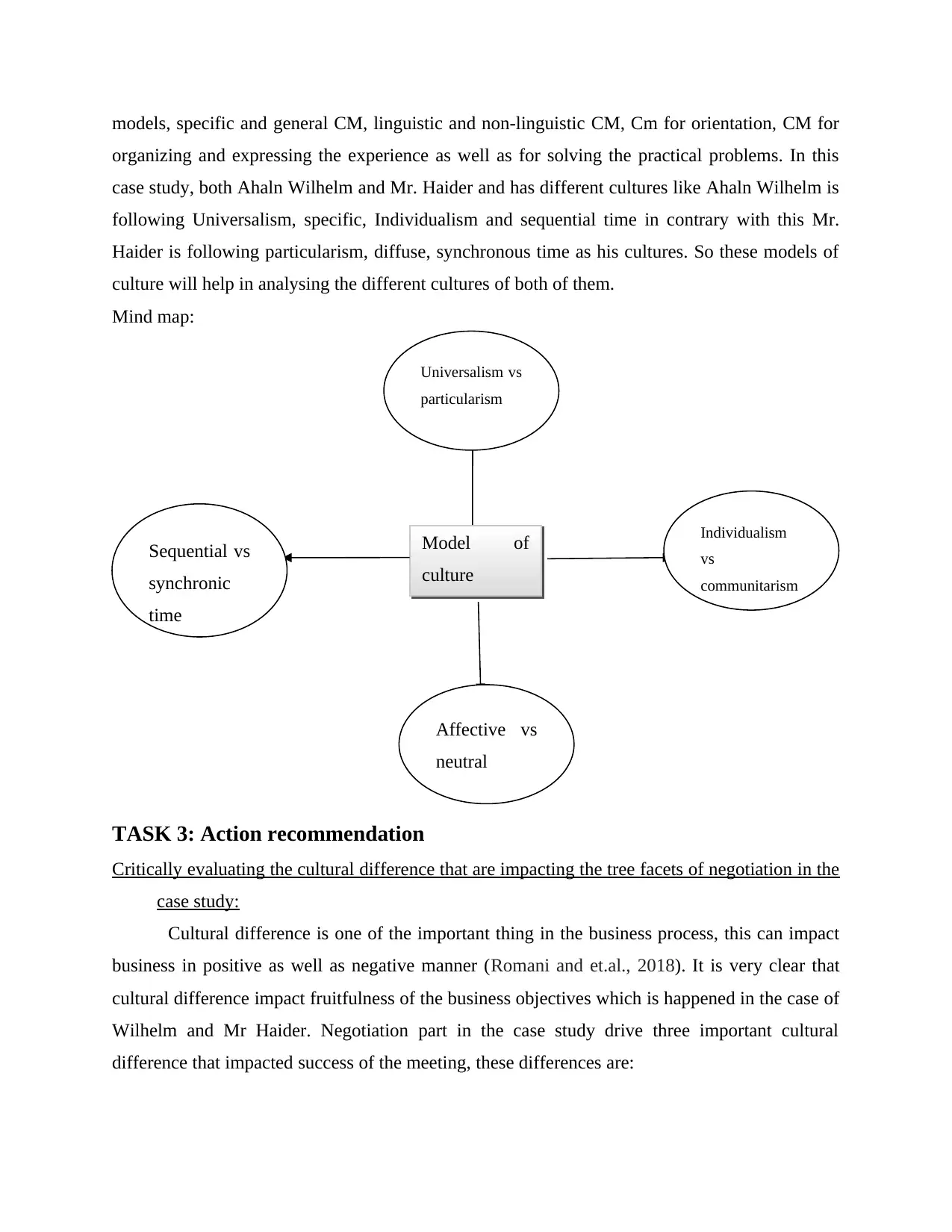
models, specific and general CM, linguistic and non-linguistic CM, Cm for orientation, CM for
organizing and expressing the experience as well as for solving the practical problems. In this
case study, both Ahaln Wilhelm and Mr. Haider and has different cultures like Ahaln Wilhelm is
following Universalism, specific, Individualism and sequential time in contrary with this Mr.
Haider is following particularism, diffuse, synchronous time as his cultures. So these models of
culture will help in analysing the different cultures of both of them.
Mind map:
TASK 3: Action recommendation
Critically evaluating the cultural difference that are impacting the tree facets of negotiation in the
case study:
Cultural difference is one of the important thing in the business process, this can impact
business in positive as well as negative manner (Romani and et.al., 2018). It is very clear that
cultural difference impact fruitfulness of the business objectives which is happened in the case of
Wilhelm and Mr Haider. Negotiation part in the case study drive three important cultural
difference that impacted success of the meeting, these differences are:
Model of
culture
Sequential vs
synchronic
time
Universalism vs
particularism
Individualism
vs
communitarism
Affective vs
neutral
organizing and expressing the experience as well as for solving the practical problems. In this
case study, both Ahaln Wilhelm and Mr. Haider and has different cultures like Ahaln Wilhelm is
following Universalism, specific, Individualism and sequential time in contrary with this Mr.
Haider is following particularism, diffuse, synchronous time as his cultures. So these models of
culture will help in analysing the different cultures of both of them.
Mind map:
TASK 3: Action recommendation
Critically evaluating the cultural difference that are impacting the tree facets of negotiation in the
case study:
Cultural difference is one of the important thing in the business process, this can impact
business in positive as well as negative manner (Romani and et.al., 2018). It is very clear that
cultural difference impact fruitfulness of the business objectives which is happened in the case of
Wilhelm and Mr Haider. Negotiation part in the case study drive three important cultural
difference that impacted success of the meeting, these differences are:
Model of
culture
Sequential vs
synchronic
time
Universalism vs
particularism
Individualism
vs
communitarism
Affective vs
neutral
⊘ This is a preview!⊘
Do you want full access?
Subscribe today to unlock all pages.

Trusted by 1+ million students worldwide
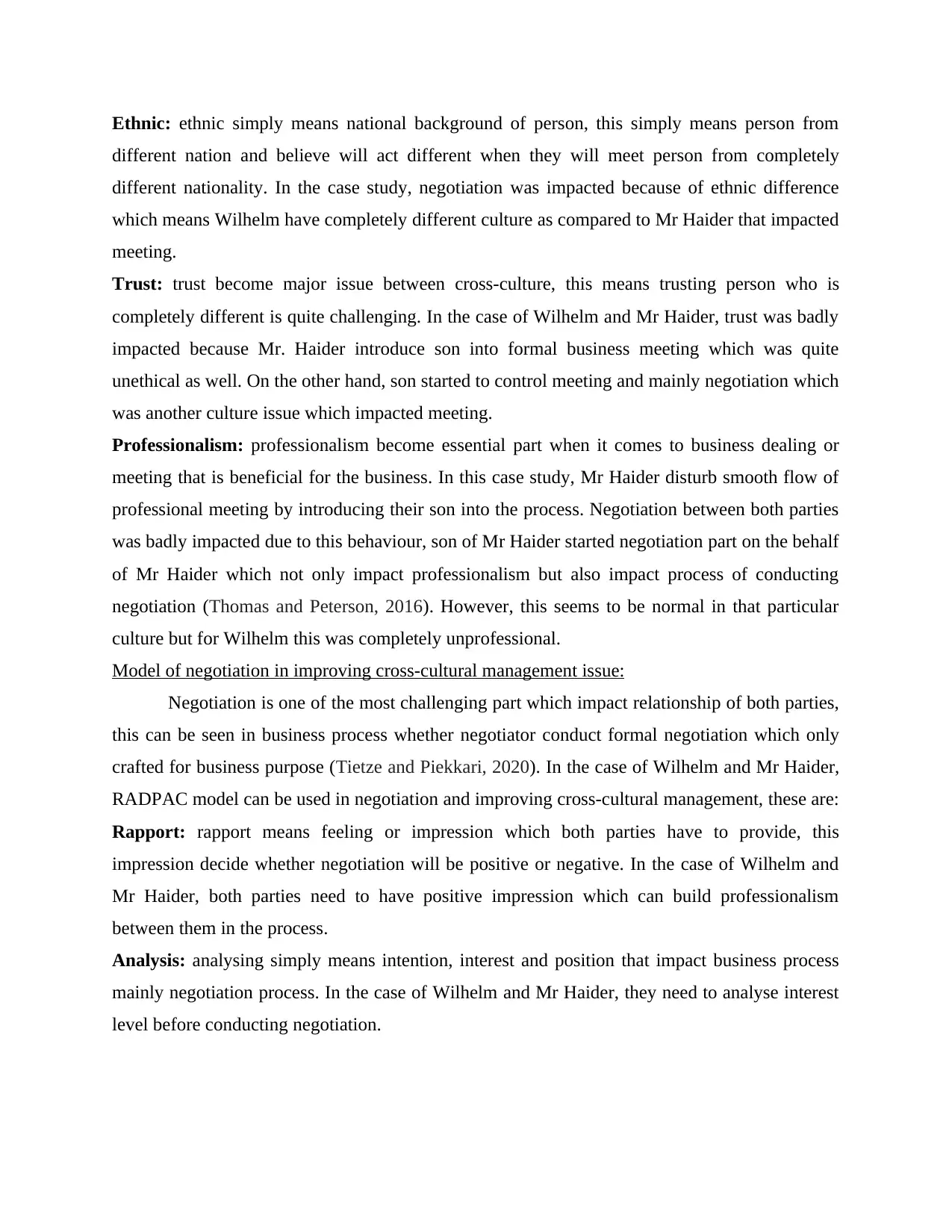
Ethnic: ethnic simply means national background of person, this simply means person from
different nation and believe will act different when they will meet person from completely
different nationality. In the case study, negotiation was impacted because of ethnic difference
which means Wilhelm have completely different culture as compared to Mr Haider that impacted
meeting.
Trust: trust become major issue between cross-culture, this means trusting person who is
completely different is quite challenging. In the case of Wilhelm and Mr Haider, trust was badly
impacted because Mr. Haider introduce son into formal business meeting which was quite
unethical as well. On the other hand, son started to control meeting and mainly negotiation which
was another culture issue which impacted meeting.
Professionalism: professionalism become essential part when it comes to business dealing or
meeting that is beneficial for the business. In this case study, Mr Haider disturb smooth flow of
professional meeting by introducing their son into the process. Negotiation between both parties
was badly impacted due to this behaviour, son of Mr Haider started negotiation part on the behalf
of Mr Haider which not only impact professionalism but also impact process of conducting
negotiation (Thomas and Peterson, 2016). However, this seems to be normal in that particular
culture but for Wilhelm this was completely unprofessional.
Model of negotiation in improving cross-cultural management issue:
Negotiation is one of the most challenging part which impact relationship of both parties,
this can be seen in business process whether negotiator conduct formal negotiation which only
crafted for business purpose (Tietze and Piekkari, 2020). In the case of Wilhelm and Mr Haider,
RADPAC model can be used in negotiation and improving cross-cultural management, these are:
Rapport: rapport means feeling or impression which both parties have to provide, this
impression decide whether negotiation will be positive or negative. In the case of Wilhelm and
Mr Haider, both parties need to have positive impression which can build professionalism
between them in the process.
Analysis: analysing simply means intention, interest and position that impact business process
mainly negotiation process. In the case of Wilhelm and Mr Haider, they need to analyse interest
level before conducting negotiation.
different nation and believe will act different when they will meet person from completely
different nationality. In the case study, negotiation was impacted because of ethnic difference
which means Wilhelm have completely different culture as compared to Mr Haider that impacted
meeting.
Trust: trust become major issue between cross-culture, this means trusting person who is
completely different is quite challenging. In the case of Wilhelm and Mr Haider, trust was badly
impacted because Mr. Haider introduce son into formal business meeting which was quite
unethical as well. On the other hand, son started to control meeting and mainly negotiation which
was another culture issue which impacted meeting.
Professionalism: professionalism become essential part when it comes to business dealing or
meeting that is beneficial for the business. In this case study, Mr Haider disturb smooth flow of
professional meeting by introducing their son into the process. Negotiation between both parties
was badly impacted due to this behaviour, son of Mr Haider started negotiation part on the behalf
of Mr Haider which not only impact professionalism but also impact process of conducting
negotiation (Thomas and Peterson, 2016). However, this seems to be normal in that particular
culture but for Wilhelm this was completely unprofessional.
Model of negotiation in improving cross-cultural management issue:
Negotiation is one of the most challenging part which impact relationship of both parties,
this can be seen in business process whether negotiator conduct formal negotiation which only
crafted for business purpose (Tietze and Piekkari, 2020). In the case of Wilhelm and Mr Haider,
RADPAC model can be used in negotiation and improving cross-cultural management, these are:
Rapport: rapport means feeling or impression which both parties have to provide, this
impression decide whether negotiation will be positive or negative. In the case of Wilhelm and
Mr Haider, both parties need to have positive impression which can build professionalism
between them in the process.
Analysis: analysing simply means intention, interest and position that impact business process
mainly negotiation process. In the case of Wilhelm and Mr Haider, they need to analyse interest
level before conducting negotiation.
Paraphrase This Document
Need a fresh take? Get an instant paraphrase of this document with our AI Paraphraser
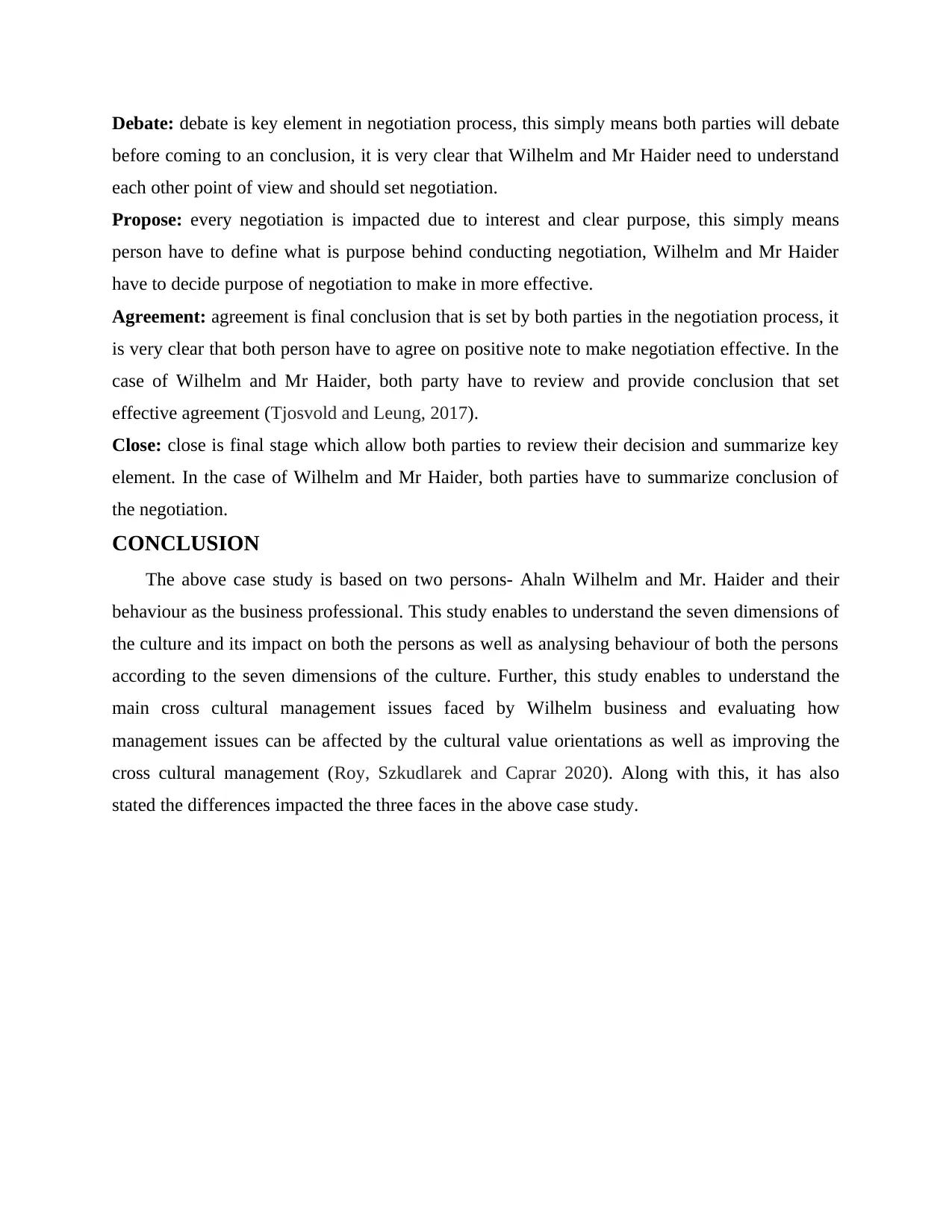
Debate: debate is key element in negotiation process, this simply means both parties will debate
before coming to an conclusion, it is very clear that Wilhelm and Mr Haider need to understand
each other point of view and should set negotiation.
Propose: every negotiation is impacted due to interest and clear purpose, this simply means
person have to define what is purpose behind conducting negotiation, Wilhelm and Mr Haider
have to decide purpose of negotiation to make in more effective.
Agreement: agreement is final conclusion that is set by both parties in the negotiation process, it
is very clear that both person have to agree on positive note to make negotiation effective. In the
case of Wilhelm and Mr Haider, both party have to review and provide conclusion that set
effective agreement (Tjosvold and Leung, 2017).
Close: close is final stage which allow both parties to review their decision and summarize key
element. In the case of Wilhelm and Mr Haider, both parties have to summarize conclusion of
the negotiation.
CONCLUSION
The above case study is based on two persons- Ahaln Wilhelm and Mr. Haider and their
behaviour as the business professional. This study enables to understand the seven dimensions of
the culture and its impact on both the persons as well as analysing behaviour of both the persons
according to the seven dimensions of the culture. Further, this study enables to understand the
main cross cultural management issues faced by Wilhelm business and evaluating how
management issues can be affected by the cultural value orientations as well as improving the
cross cultural management (Roy, Szkudlarek and Caprar 2020). Along with this, it has also
stated the differences impacted the three faces in the above case study.
before coming to an conclusion, it is very clear that Wilhelm and Mr Haider need to understand
each other point of view and should set negotiation.
Propose: every negotiation is impacted due to interest and clear purpose, this simply means
person have to define what is purpose behind conducting negotiation, Wilhelm and Mr Haider
have to decide purpose of negotiation to make in more effective.
Agreement: agreement is final conclusion that is set by both parties in the negotiation process, it
is very clear that both person have to agree on positive note to make negotiation effective. In the
case of Wilhelm and Mr Haider, both party have to review and provide conclusion that set
effective agreement (Tjosvold and Leung, 2017).
Close: close is final stage which allow both parties to review their decision and summarize key
element. In the case of Wilhelm and Mr Haider, both parties have to summarize conclusion of
the negotiation.
CONCLUSION
The above case study is based on two persons- Ahaln Wilhelm and Mr. Haider and their
behaviour as the business professional. This study enables to understand the seven dimensions of
the culture and its impact on both the persons as well as analysing behaviour of both the persons
according to the seven dimensions of the culture. Further, this study enables to understand the
main cross cultural management issues faced by Wilhelm business and evaluating how
management issues can be affected by the cultural value orientations as well as improving the
cross cultural management (Roy, Szkudlarek and Caprar 2020). Along with this, it has also
stated the differences impacted the three faces in the above case study.
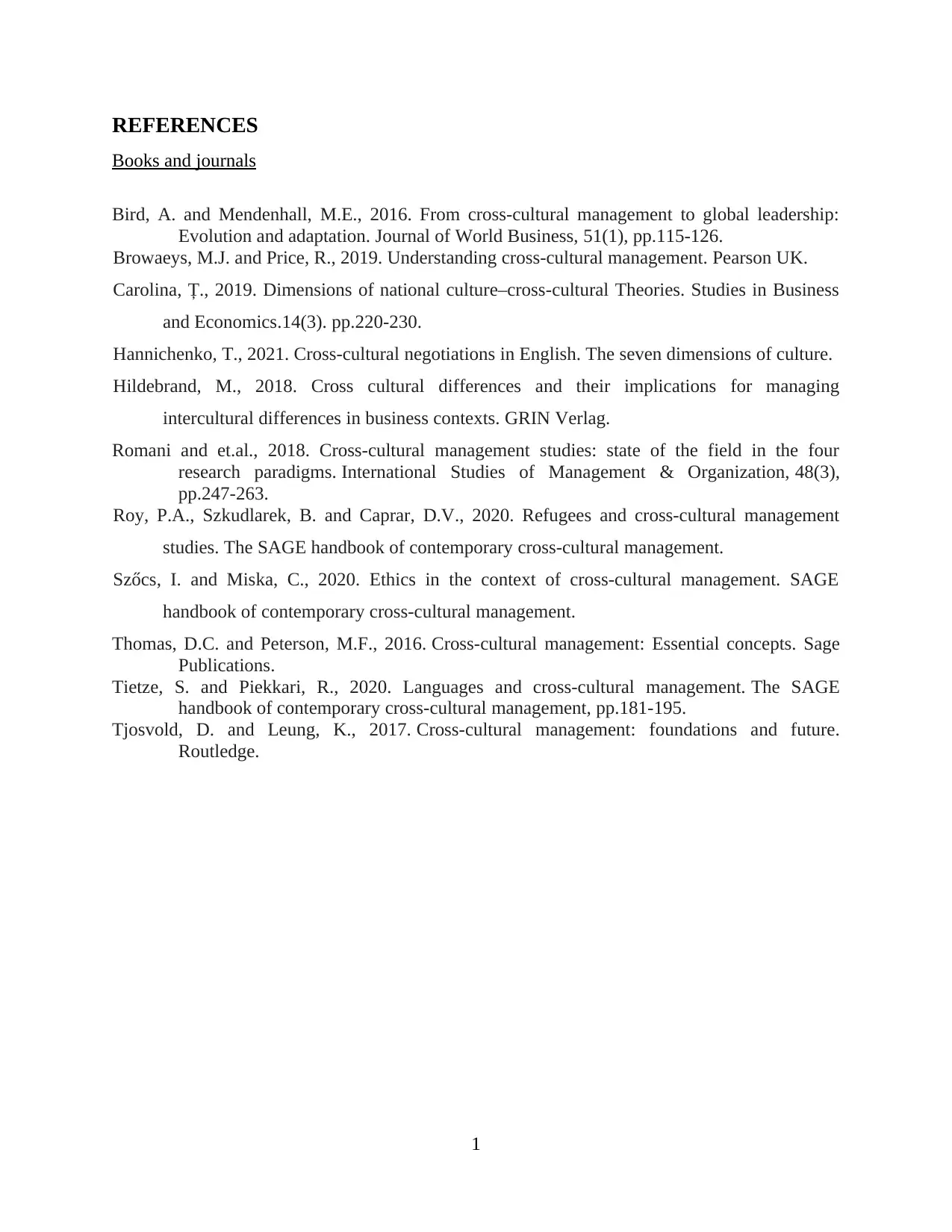
REFERENCES
Books and journals
Bird, A. and Mendenhall, M.E., 2016. From cross-cultural management to global leadership:
Evolution and adaptation. Journal of World Business, 51(1), pp.115-126.
Browaeys, M.J. and Price, R., 2019. Understanding cross-cultural management. Pearson UK.
Carolina, Ț., 2019. Dimensions of national culture–cross-cultural Theories. Studies in Business
and Economics.14(3). pp.220-230.
Hannichenko, T., 2021. Сross-cultural negotiations in English. The seven dimensions of culture.
Hildebrand, M., 2018. Cross cultural differences and their implications for managing
intercultural differences in business contexts. GRIN Verlag.
Romani and et.al., 2018. Cross-cultural management studies: state of the field in the four
research paradigms. International Studies of Management & Organization, 48(3),
pp.247-263.
Roy, P.A., Szkudlarek, B. and Caprar, D.V., 2020. Refugees and cross-cultural management
studies. The SAGE handbook of contemporary cross-cultural management.
Szőcs, I. and Miska, C., 2020. Ethics in the context of cross-cultural management. SAGE
handbook of contemporary cross-cultural management.
Thomas, D.C. and Peterson, M.F., 2016. Cross-cultural management: Essential concepts. Sage
Publications.
Tietze, S. and Piekkari, R., 2020. Languages and cross-cultural management. The SAGE
handbook of contemporary cross-cultural management, pp.181-195.
Tjosvold, D. and Leung, K., 2017. Cross-cultural management: foundations and future.
Routledge.
1
Books and journals
Bird, A. and Mendenhall, M.E., 2016. From cross-cultural management to global leadership:
Evolution and adaptation. Journal of World Business, 51(1), pp.115-126.
Browaeys, M.J. and Price, R., 2019. Understanding cross-cultural management. Pearson UK.
Carolina, Ț., 2019. Dimensions of national culture–cross-cultural Theories. Studies in Business
and Economics.14(3). pp.220-230.
Hannichenko, T., 2021. Сross-cultural negotiations in English. The seven dimensions of culture.
Hildebrand, M., 2018. Cross cultural differences and their implications for managing
intercultural differences in business contexts. GRIN Verlag.
Romani and et.al., 2018. Cross-cultural management studies: state of the field in the four
research paradigms. International Studies of Management & Organization, 48(3),
pp.247-263.
Roy, P.A., Szkudlarek, B. and Caprar, D.V., 2020. Refugees and cross-cultural management
studies. The SAGE handbook of contemporary cross-cultural management.
Szőcs, I. and Miska, C., 2020. Ethics in the context of cross-cultural management. SAGE
handbook of contemporary cross-cultural management.
Thomas, D.C. and Peterson, M.F., 2016. Cross-cultural management: Essential concepts. Sage
Publications.
Tietze, S. and Piekkari, R., 2020. Languages and cross-cultural management. The SAGE
handbook of contemporary cross-cultural management, pp.181-195.
Tjosvold, D. and Leung, K., 2017. Cross-cultural management: foundations and future.
Routledge.
1
⊘ This is a preview!⊘
Do you want full access?
Subscribe today to unlock all pages.

Trusted by 1+ million students worldwide

2
1 out of 10
Related Documents
Your All-in-One AI-Powered Toolkit for Academic Success.
+13062052269
info@desklib.com
Available 24*7 on WhatsApp / Email
![[object Object]](/_next/static/media/star-bottom.7253800d.svg)
Unlock your academic potential
Copyright © 2020–2025 A2Z Services. All Rights Reserved. Developed and managed by ZUCOL.



